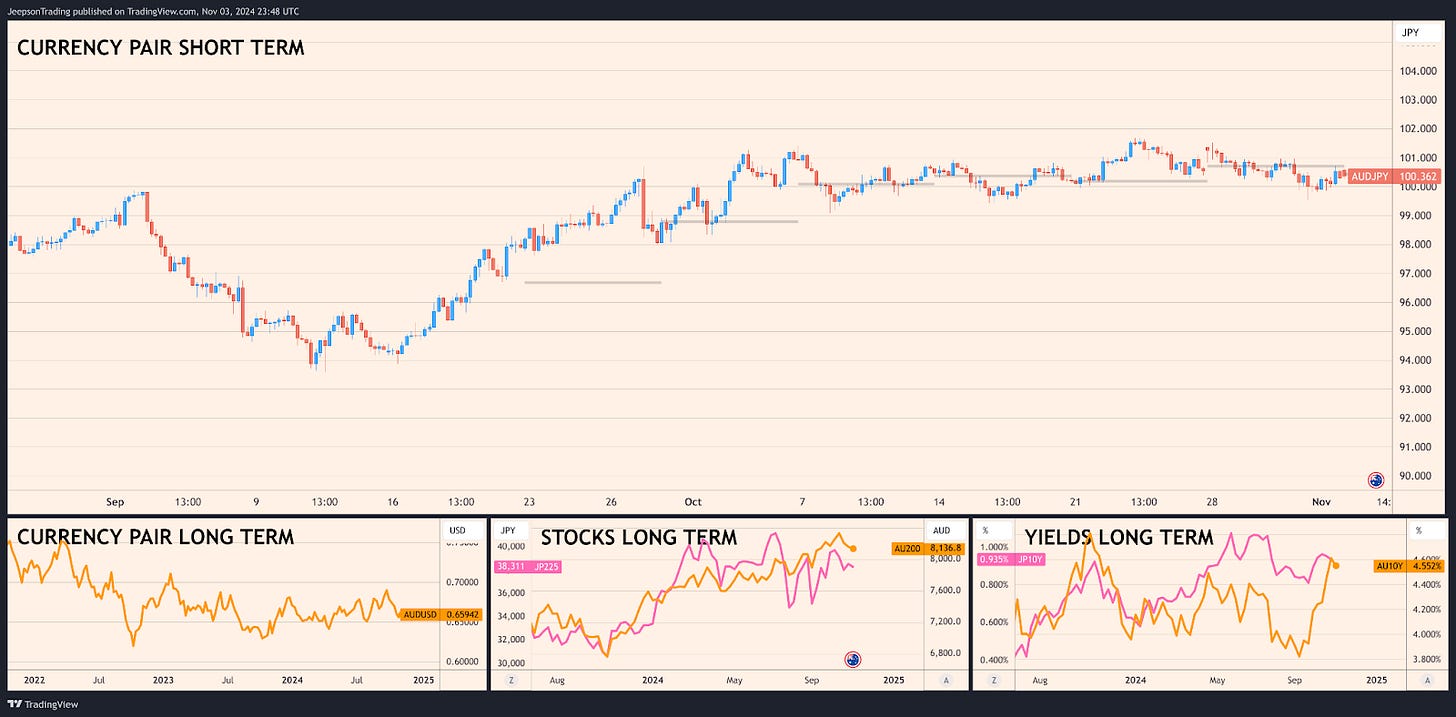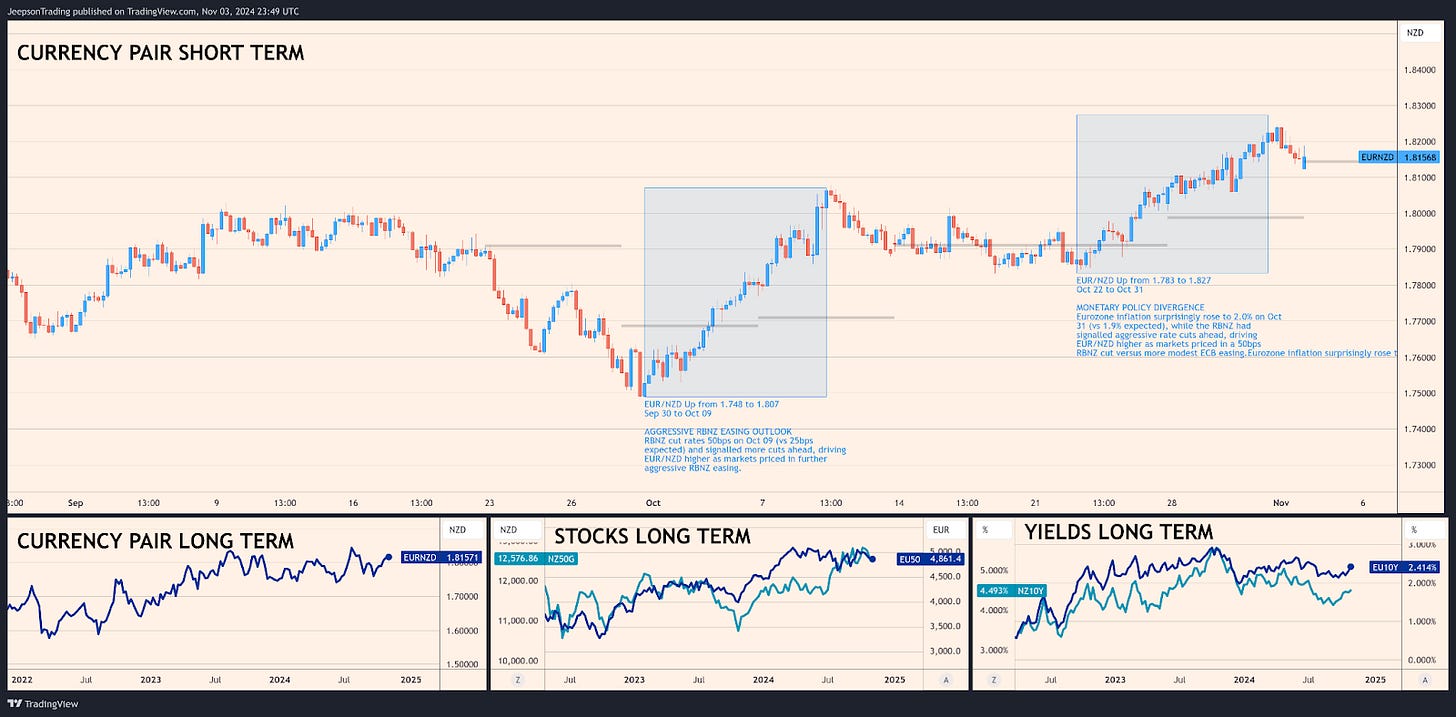Election Risk and Policy Divergence Shape FX Markets
Monday, November 04, 2024 (Week 44)
This briefing focuses on three currency pairs offering compelling trading opportunities during the upcoming week. GBP/USD presents clear directional potential as the Bank of England signals faster rate cuts while markets process a potential Trump presidency's impact on Federal Reserve policy. AUD/JPY offers volatility opportunities around Tuesday's RBA meeting and continued BOJ policy divergence. EUR/NZD captures the stark contrast between ECB's measured approach and RBNZ's aggressive 50 bps cut, with further policy decisions ahead.
The selection prioritises pairs with strong directional drivers, clear technical levels, and upcoming high-impact events. Adding significance, the US presidential election countdown introduces volatility potential across USD pairs, while central bank meetings for the Fed, BOE, and RBA coming up create specific entry opportunities. Each pair also benefits from deep market liquidity and reasonable spreads during main trading sessions, crucial considerations for position execution.
GBP/USD: Election Risk Amplifies Policy Divergence
The British pound faces dual pressures against the US dollar: BOE Governor Bailey's shift toward aggressive rate cuts and mounting US election uncertainty. Deutsche Bank's analysis suggests asymmetric dollar risks, with limited downside in a divided government scenario but significant upside potential under a Republican sweep.
GBP/USD declined from 1.342 to 1.306 between September 30 and October 4, driven by:
BOE Governor Bailey's hints at accelerated rate cuts
Strong US jobs report showing 254,000 jobs added in September
Trump leading in five of seven key swing states as of October 31st
Additional pressure emerged October 30-31, with GBP/USD falling from 1.304 to 1.284 after:
Labour's first budget unveiled £40 billion in tax hikes
Goldman Sachs projecting higher near-term inflation under potential Trump policies
Polls showing Trump and Harris neck-and-neck
Recent: UK:
Tue, Oct 30: Labour's first budget presentation
Wed, Oct 31: UK Manufacturing PMI fell to 49.9
Thu, Nov 01: Bank of England rate decision
Recent US:
Thu, Oct 31: Core PCE Price Index data
Fri, Nov 01: Nonfarm Payrolls (12K vs 113K expected)
Ongoing: Presidential election polling showing tight race
Upcoming: UK:
Thu, Nov 07: Bank of England Interest Rate Decision
Thu, Nov 14: UK GDP Growth Rate QoQ
Fri, Nov 15: UK Retail Sales MoM
Upcoming US:
Tue, Nov 05: Presidential Election
Thu, Nov 07: Fed Interest Rate Decision
Mon, Nov 11: Fed Bowman Speech
AUD/JPY: Contrasting Policy Approaches Drive Direction
The Australian dollar versus Japanese yen cross rate reflects monetary policy divergence between the RBA and BOJ, with inflation trajectories playing a crucial role in both countries' policy decisions.
Japan:
Japanese inflation fell to 2.5% in September from 3.0%
BOJ maintained rates at 0.25% in October meeting
Japanese consumer confidence declined to 36.2 in October
Australia:
RBA held cash rate at 4.35%
Employment surged by 64,100 jobs in September
Business confidence improved to -2 in September
Upcoming: Japan:
Wed, Nov 06: BOJ Monetary Policy Meeting Minutes
Wed, Nov 06: Jibun Bank Services PMI Final
Fri, Nov 08: Reuters Tankan Index
Upcoming Australia:
Tue, Nov 05: RBA Interest Rate Decision
Tue, Nov 05: RBA Press Conference
Thu, Nov 07: Balance of Trade
EUR/NZD: Policy Divergence Drives Record Gains
EUR/NZD surged between October 22-31, climbing from 1.783 to 1.827 as monetary policy divergence widened between the ECB's measured stance and RBNZ's aggressive easing.
Eurozone:
Annual inflation rose to 2.0% in October
GDP expanded 0.4% in Q3 2024
Manufacturing PMI rose to 45.9 in October
New Zealand:
RBNZ cut rates 50 bps to 4.75%
Annual inflation fell to 2.2% in Q3
Manufacturing PMI improved to 46.9 in September
Key Events
Upcoming New Zealand:
Tue, Nov 05: RBNZ Financial Stability Report
Tue, Nov 05: Employment Change QoQ
Tue, Nov 05: Unemployment Rate
Market Outlook
Currency markets face a pivotal period with the US presidential election potentially reshaping global trade and monetary policy dynamics. ING highlights several key considerations:
Republican Sweep:
Potential 5% handle for 10-year yields amid aggressive fiscal expansion
Upward pressure on USD across major pairs
Increased volatility in trade-sensitive currencies
Split Government:
Moderate yield increases driven by inflation concerns
Limited USD movement
More stable trading conditions
Democratic Victory:
More contained yield movement
Lower growth prospects weighing on USD
Focus on conventional monetary policy transmission
Key Risks
Election uncertainty with key state margins within 0.5% triggering automatic recounts
Pennsylvania's final results legally required by November 26th
Middle East conflict escalation could trigger safe-haven flows
Multiple central bank decisions may surprise market expectations
UK fiscal outlook uncertainty following Labour's budget
Chinese economic data impact on commodity currencies
Sources
Bank of England, Federal Reserve, European Central Bank, Reserve Bank of New Zealand, Bank of Japan, Reserve Bank of Australia, Trading Economics, Statistics New Zealand, Australian Bureau of Statistics, Credit Agricole FX Analysis, Deutsche Bank Currency Projections, ING Market Scenarios, Goldman Sachs Economic Forecasts, FiveThirtyEight Election Data.





